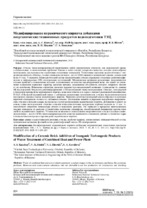| dc.contributor.author | Ковчур, A. C. | |
| dc.contributor.author | Шелег, В. К. | |
| dc.contributor.author | Жорник, В. И. | |
| dc.contributor.author | Ковалева, С. А. | |
| dc.coverage.spatial | Минск | ru |
| dc.date.accessioned | 2020-06-09T09:36:22Z | |
| dc.date.available | 2020-06-09T09:36:22Z | |
| dc.date.issued | 2020 | |
| dc.identifier.citation | Модифицирование керамического кирпича добавками неорганических техногенных продуктов водоподготовки ТЭЦ = Modification of a Ceramic Brick Additives of Inorganic Technogenic Products of Water Treatment of Combined Heat and Power Plant / A. C. Ковчур [и др.] // Наука и техника. – 2020. – № 3. – С. 204-214. | ru |
| dc.identifier.uri | https://rep.bntu.by/handle/data/73545 | |
| dc.description.abstract | Отходы теплоэлектроцентралей представляют собой определенную опасность для окружающей среды, а следовательно, и экономические проблемы. Однако в таких отходах содержатся вещества, которые целесообразно использовать для производства строительно-отделочных материалов. Техногенные продукты водоподготовки с теплоэлектроцентрали «Южная» (осадки химводоподготовки – код 8410500) являются кальцитовой смесью, содержащей более 64 мас. % кальцита. Минералогический состав неорганических отходов определен с помощью рентгенографических и инфракрасных (ИК) спектральных исследований. Механическая активация кальцитовых неорганических отходов приводит к измельчению кальцита и уменьшению количества адсорбированной воды, что влияет на увеличение содержания каркасных структур диоксида кремния, реакционная способность которого напрямую зависит от их количества. Изменения структуры диоксида кремния при механической активации установлены по данным ИК-исследований. Результаты рентгенографических и ИК-исследований глины месторождения «Заполье», используемой в технологии производства керамического кирпича, позволяют отнести ее к сырью с высокой реакционной способностью. В ОАО «Обольский керамический завод» с добавками кальцитовых неорганических отходов теплоэлектроцентрали произведена опытная партия керамического кирпича. Выполнен рентгеноструктурный анализ образцов полученных кирпичей стандартного состава и с добавками отходов. Исследовано влияние содержания кальцитовых неорганических отходов в исходном сырье на процессы структурообразования керамического кирпича. Добавление в шихту на основе глины месторождения «Заполье» отходов химводоподготовки, содержащих карбонат кальция до 15 мас. %, способствует снижению температуры обжига и появлению расплава. Это приводит к процессам кристаллизации твердых минералов из расплава и увеличению количества стеклофазы, способствующей повышению прочностных свойств керамического кирпича. Установлена возможность использования неорганических отходов (осадков химводоподготовки – код 8410500) теплоэлектроцентралей в качестве компонента отощающих добавок в глинистое сырье в технологическом процессе производства керамического кирпича. | ru |
| dc.language.iso | ru | ru |
| dc.publisher | БНТУ | ru |
| dc.title | Модифицирование керамического кирпича добавками неорганических техногенных продуктов водоподготовки ТЭЦ | ru |
| dc.title.alternative | Modification of a Ceramic Brick Additives of Inorganic Technogenic Products of Water Treatment of Combined Heat and Power Plant | ru |
| dc.type | Article | ru |
| dc.identifier.doi | 10.21122/2227-1031-2020-19-3-204-214 | |
| local.description.annotation | Waste of combined heat and power plants represents a certain danger to the environment, and hence the economic problems. However such waste contains substances that are advisable to use for production of construction and finishing materials. Technogenic products of water treatment from the Yuzhnaya combined heat and power plant (sludges of chemical water treatment – code 8410500) are a calcite mixture containing more than 64 wt. % calcite. The mineralogical composition of inorganic waste has been determined while using X-ray and IR-spectral researches. Mechanical activation of calcite inorganic wastes leads to grinding of calcite and a decrease in the amount of adsorbed water, which affects the increase in the content of silica frame structures, the reactivity of which directly depends on their quantity. Changes in the structure of silicon dioxide during mechanical activation are established according to IR studies. The results of X-ray and IR studies of the Zapolie deposit clay used in ceramic brick production technology make it possible to attribute it to raw materials with high reactivity. An experimental batch of ceramic bricks has been produced at JSC “Obolsky Ceramic Plant” with addition of calcite inorganic waste from combined heat and power plants. An X-ray diffraction analysis of samples of the obtained bricks having standard composition and with addition of waste has been carried out. The influence of calcite inorganic waste content in the feedstock on the process of ceramic brick structure formation has been studied in the paper. Addition of chemical water treatment waste containing calcium carbonate up to 15 wt. % to the Zapolye clay mixture helps to reduce a firing temperature and an appearance of the melt. This leads to crystallization processes of solid minerals from the melt and an increase in the amount of glass phase which contributes to improvement of strength properties in ceramic bricks. The possibility of using inorganic waste (sludges of chemical water treatment – code 8410500) of combined heat and power plants as a component of emaciated additives in clay raw materials in the process of ceramic brick production has been established in the paper. | ru |

